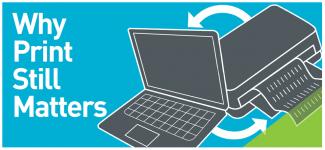
Why Print Still Matters for the 21st Century | MKP communications inc.
By Amy Hanauer, Assistant Production Manager
In early February, I sat, watching my wristwatch tick the remaining cold days of winter away, and waited for my W-2 tax form to come in the mail from my previous employer so I could file my taxes on time. Each day, I would open my mailbox and find that the form hadn’t been delivered. Anxiety filled my mind like a beating metronome back and forth. I wondered if the mail gods would somehow hear my pleas. I emailed my former company’s human resources department, but they were unable to retrieve the form electronically for me. If I didn’t get my printed W-2 form, how could I file my taxes? (Sure, I could file an extension with the IRS if I really had to, but who wants to do that?) All I could do was wait for the printed document to come in the mail.
The clock ticked and ticked.
Finally, the USPS delivered that critically important printed document for me, my W-2 form! Relief washed over me and a printed document was the savior of the day again.
It made me think, wow, print still matters, even in the 21st century.
In 2022, $78.9 billion worth of printed material is expected to be produced in the United States and printing is slated to increase 1.6%.1 This increase may not seem like a lot, but when you calculate the volume and think about the billions of printed pieces being produced, it really is staggering. Print is still clearly a force in the world of communications.
Historically, the printed word can be traced to the earliest cave paintings. Even now, centuries later, discoveries of these artifacts are still telling the history of humanity. The Phoenicians modernized the art of communication with the invention of the alphabet and development of language. Egyptians and Greeks furthered these initial innovations and developed vast systems of communication. After the Roman empire fell and the Dark Ages descended upon Western Civilization, monks and the Moors spun words into books to keep their messages and traditions alive. Without this commitment to preserve their stories, history as we know it would be lost. And then, Johannes Gutenberg invented the first movable-type printing press in 1440, and the print industry was revolutionized.
Even while digital communication continues to grow, print is still important and they increasingly work in tandem. For example, when banks merge and product and service changes occur, banks are required by law to send out communications to let their customers know what and when changes are happening. Printed materials delivered in the mail are crucial to ensure that requirements have been met.
Digital communications offer accessibility and enhance what may be communicated via print. Newspapers now have websites and content that is updated round-the-clock. Social media transforms content into digestible chunks for a rapidly changing world. Digital programs offer translation into multiple languages and provide accessibility. These tools work in concert with print and provide dynamic and creative media enhancements. In marketing and public relations, tactics like Search Engine Optimization (SEO) and quantitative data analysis are now standard operating procedure to help communications professionals achieve their objectives.
And yet, print is still critical. What happens when you cannot access the internet or you lose power or coverage? Printed material is often produced in a multitude of languages to spread a message far and wide. For the visually impaired, Braille printed material is crucial. Regulatory agencies like the Securities and Exchange Commission legally require financial documents to be printed and mailed. Digital is key, but the need for print remains.
The commercial print industry includes approximately 35,000 companies in the United States, and it generates approximately $90 billion in revenue2 each year. As someone who worked in a print plant every day and who now communicates daily with print and mail vendors, seeing this process at work is unlike any other endeavor. There is nothing like walking into a print shop and hearing the constant hum of the presses going.
We’ve come a long way from Gutenberg’s initial press and, through this astounding progress, the print industry thrives. Large offset presses churn out large sheets of pristine four-color brochures. It’s almost mind-blowing just how quickly paper spins out with the printed copy already on it. A web press can produce forms so quickly on a large print run that by the time I close and open my eyes, the printed material is ready to be cut and folded. Ink comes alive on a paper form from the imposed plates. A digital press can even produce a job on a quick turnaround for material that must be in the mail the same day.
The next time you open your mailbox, go to curl up with your favorite book or try to complete the crossword from your newspaper, remember that the printed material you’re holding was carefully and painstakingly produced in order to make its way into your hands.
So, yes, you can log into a website and scroll away, and it’s very convenient to use the digital communication tools at your fingertips, but remember that print and digital are partners in a great symphony. If one instrument is out of tune, the symphony can become entirely discordant. But, when playing out together, in harmony, the notes can make a beautiful concert come alive.
MKP communications inc. is a New York City-based communications company specializing in financial services marketing and merger/change communication.
1 Ibis World: https://www.ibisworld.com/industry-statistics/market-size/printing-united-states/
2 First Research: https://www.firstresearch.com/industryanalysis/commercialprinting.html